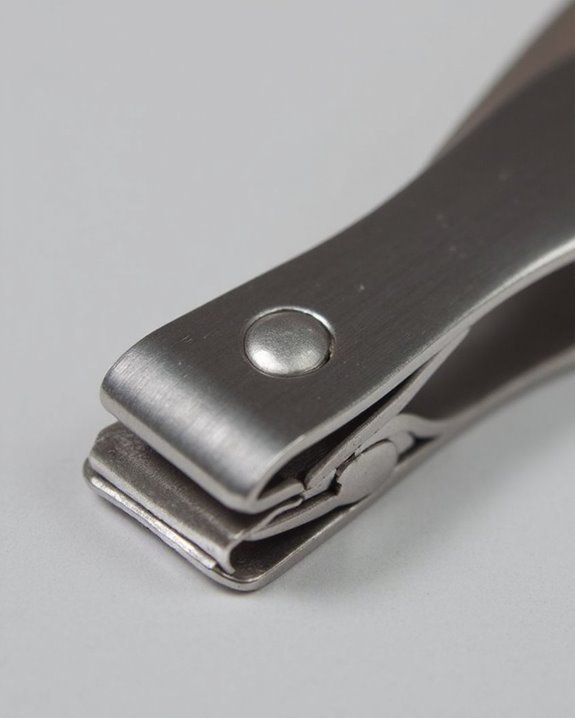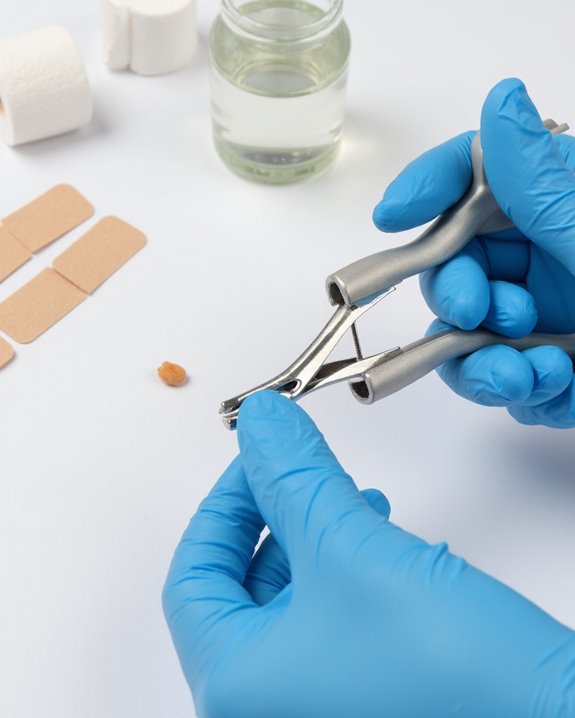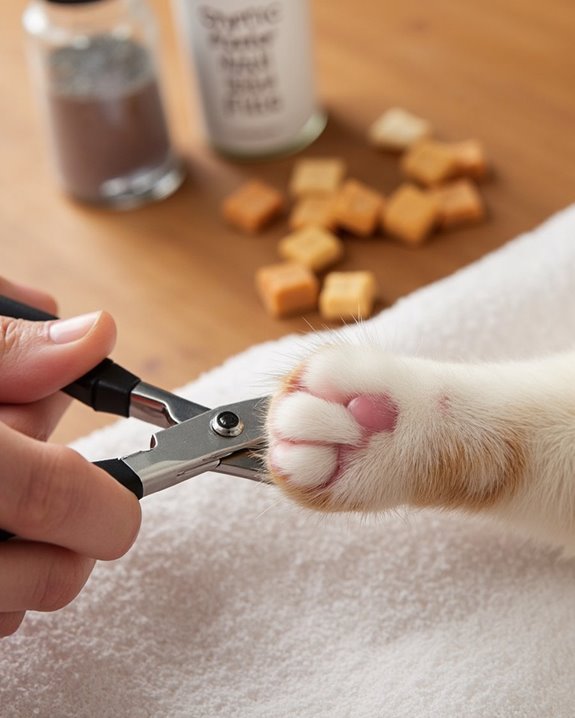According to TSA rules, standard nail clippers are permitted in both carry-on and checked luggage. For carry-ons, make sure any attached blade is less than 4 inches long. I recommend wrapping clippers in a protective sheath and placing them in your clear toiletry bag for easy inspection. Pointed-end nail scissors, however, should go in checked baggage. For international flights, verify destination country regulations as policies vary greatly between nations. The following guidelines will help you navigate specific airline requirements.
Key Takeaways
- Standard nail clippers are permitted in both carry-on and checked baggage with no restrictions.
- Nail scissors are allowed in carry-on luggage only if the blades are shorter than 4 inches.
- Multitools containing nail clippers and other sharp objects must be packed in checked baggage.
- Wrap sharp edges in a protective sheath or cloth to prevent injuries to baggage handlers.
- International travel requires verifying destination country regulations, as policies vary significantly between nations.
Current TSA Regulations for Nail Clippers
The Transportation Security Administration (TSA) has established clear guidelines regarding nail clippers in air travel, which I’m happy to clarify for your next flight. Standard nail clippers are allowed in both carry-on luggage and checked baggage, as they’re considered non-dangerous personal care items with blades typically measuring under 4 inches. High-quality materials used in nail clippers ensure they are safe and durable for travel. When packing nail scissors, however, you’ll need to be more careful with the regulations. The TSA permits nail scissors with blades shorter than 4 inches in carry-on bags, but pointed-end versions must go in checked baggage only. For multitools that include nail clippers along with sharp objects like knives, you’ll need to place these in your checked baggage. Remember that all sharp objects, including nail clippers, should be properly sheathed or wrapped to prevent potential injuries during security inspections.
Differences Between Carry-On and Checked Baggage Rules
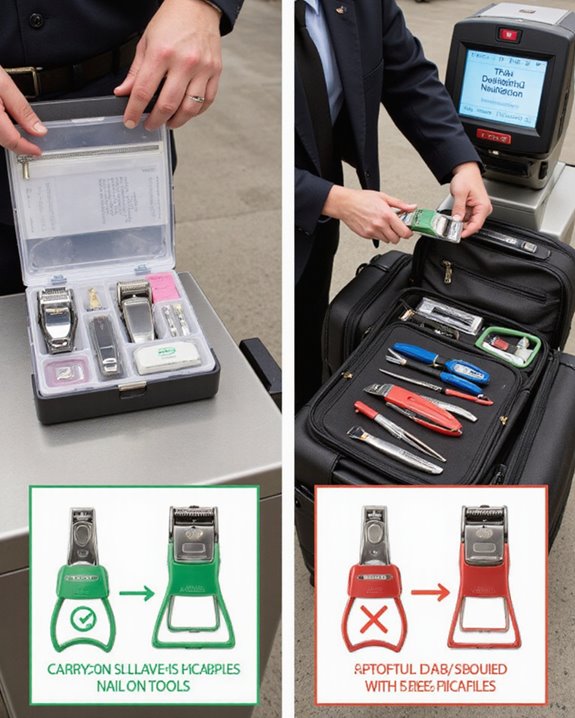
Understanding the important distinctions between carry-on and checked baggage regulations can save you significant hassle when traveling with nail clippers. When packed in carry-on luggage, nail clippers are generally allowed, but any attached blades must be less than 4 inches long, and pointed-end scissors face additional scrutiny. I recommend securing them in a sheath to prevent accidental injury to TSA officers during inspection. It’s also helpful to familiarize yourself with material quality and construction standards to determine which tools are safe to pack in your carry-on. For complete peace of mind, consider placing nail clippers in checked luggage instead, where regulations are considerably more relaxed. Sharp items that would be questioned in carry-ons can be packed in checked luggage without length restrictions or special packaging. Additionally, multitools with nail clippers that include knife attachments must be checked, as a TSA officer will likely confiscate these if found during carry-on screening.
International Airline Variations on Nail Clipper Policies
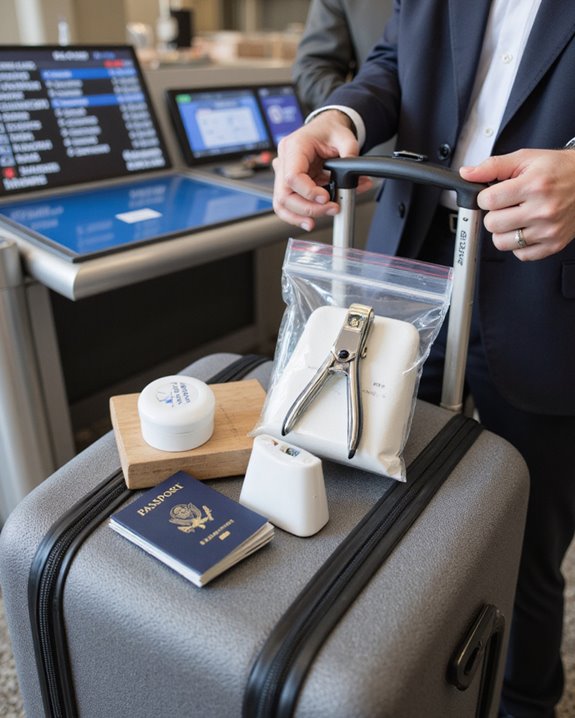
When traveling internationally, how do you navigate the maze of differing nail clipper regulations across airlines and countries? While TSA regulations in the U.S. allow nail clippers in carry-on bags if the blade length is under 4 inches, international variations create significant complexity.
The United Kingdom prohibits nail clippers completely, while Canada permits them in carry-on luggage only if they’re shorter than 6 cm. Japan enforces even stricter size limitations, requiring nail clippers to be under 4 cm. European policies generally allow sharp objects with blades under 6 cm, offering more flexibility than the U.K.’s outright ban. When flying on international airlines, I recommend checking the specific airline rules of your carrier and verifying the prohibited items list for your destination country, as policies often align with local regulations rather than your departure point’s standards.
Proper Packing Tips for Hassle-Free Security Screening

Traversing through airport security with nail clippers requires thoughtful preparation, especially after considering the varied international regulations we’ve explored. When packing nail clippers in your carry-on bags, I recommend wrapping the sharp edges in a protective sheath or cloth to prevent injury to TSA agents during security checks. Always make sure your clippers’ blade is shorter than 4 inches (10.16 cm) to comply with regulations that allow nail clippers in carry-on luggage. For maximum efficiency, place your nail clippers in a clear, quart-sized plastic bag or dedicated toiletry kit, making them easily visible for inspection. Secure them in a compartment where they won’t shift during transit, and verify they’re properly contained rather than loosely packed. These precautions will help you bring nail clippers through security with minimal delays. Additionally, opting for a professional-grade nail file set can ensure your nails are well-groomed without risking damage or injury during security checks.
Alternative Nail Care Tools for Air Travel
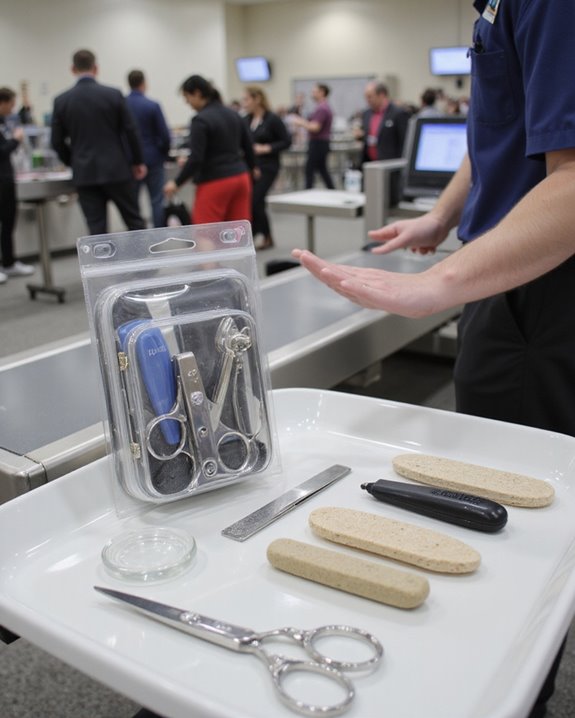
Why limit yourself to nail clippers when several TSA-approved alternatives exist for maintaining your nails during air travel? Nail scissors provide excellent precision and are allowed on planes in your carry-on, provided they comply with TSA and international regulations. For domestic flights, make sure the sharp blades measure under 4 inches, while CAA rules specify a maximum 6 cm (2.3 inches) for international travel.
Nail files offer a completely worry-free option to bring on a plane, as they face no restrictions in carry-on luggage and won’t produce flying nail clippings that could disturb fellow passengers. For those focusing on cuticle care, consider TSA-approved cuticle pushers without sharp edges. These alternatives help you maintain your nail grooming routine while seamlessly passing through security checkpoints without confiscation concerns.
What to Do If Your Nail Clippers Are Confiscated

Despite your best efforts to follow regulations, you might still face the disappointing moment when a TSA agent confiscates your nail clippers at the security checkpoint. If this happens, I recommend staying calm and accepting that these items are now gone. You’ll need to be aware that replacement nail clippers are readily available at most destinations in pharmacies or supermarkets.
When purchasing new clippers, be sure to check local markets carefully to avoid counterfeit products or inflated prices. In tourist areas, remain vigilant about pickpockets while shopping. If you’re traveling to remote locations where nail care items might be scarce, consult the TSA website beforehand to understand exactly which types of clippers should be avoided. Remember, alternatives like nail files are generally TSA-approved and can tide you over until you find replacements.
Frequently Asked Questions
Does TSA Allow Clippers?
I’m pleased to assure you that your personal grooming tools are welcome aboard! While Clippers History has evolved, TSA does indeed permit these handy devices in both carry-on and checked luggage without causing any security concerns.
Can I Carry Scissors and Nail Cutter in Flight?
I’d recommend compact travel tools for your flight grooming needs. Yes, nail cutters are allowed, but for scissors, make sure blades are under 4 inches. Consider scissors alternatives and proper packing methods to avoid security delays.
Are Nail Clippers Considered Sharps?
Let’s just say nail clippers walk a fine line. I’d consider them mild cutting implements in tool categorization. They’re personal tools with minimal edge sharpness—not classified as serious sharps in hazard identification or grooming risks safety evaluation.
What Is Not Allowed in a Carry-On Bag TSA?
I’ll tell you what’s not allowed in carry-ons: firearms, explosives, knives, oversized liquids (over 3.4oz), certain tools, many sporting goods, large batteries, some aerosols, and medication without proper documentation. Check TSA’s website for complete regulations.


